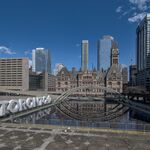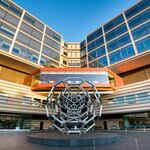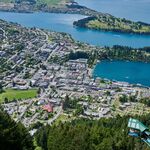I would like to see a similar video for Edmonton Transit,
@Reecemartin. I like your Calgary descriptions of hypothetical extension alternatives and I have one suggestion for Edmonton. First, I am basing my concept on the notion that not all forms of transit have to serve expediency in terms of shortest times from point A to point B; there is some room, I believe, for enjoying the ride and sightseeing as well as commuting. I am working to get support for the attached route -- an upgraded and extended line matrix for the ERRS (Edmonton Radial Railway Society), using refurbished historical stock. I am proposing eliminating the overhead power lines in favour of LSM (Linear Synchronous Motor) propulsion centered between the dual rails on the roadbed. LSM is far more efficient than conventional electric motor propulsion, "juicing" one linear segment at a time instead of the whole wire line. LSM systems are far safer as well in that two-way traffic can be accommodated on a single line without any chance of collision (propulsion is linear in direction, one way at a time per segment).

The
Red Line indicates the existing ERRS line, connecting Old Strathcona in the south to Grandin in the North. I would look at a couple of improvements to this line for efficiency sake (beyond converting propulsion to LSM). 1. I would prepare for a grade separation bridge on an extension that would cross Jasper Avenue on the north end of the line. 2. I would elevate the tracks on the south end of the line in preparation for bridging Whyte Avenue as well as passing over 105th Street, 104th Street and Gateway Boulevard. 3. I would upgrade and add station points a) at the midpoint between 106 and 107 street (adjacent to the southern terminus to Fort Hill Road, b) at the tunnel entry west of 109th street in the Garneau District, c) at the current location of a stopping point between 97 and 98 Aves., and d) at a similar stopping point north of 100th Ave. I would like to see the overpass bridges built in Trestle form, using concrete pile footings attached to steel base plates with timber superstructure, reminiscent of early railroad days. The stations, too, could emulate the style of railroad architecture familiar in Edmonton by way of the Strathcona Station. They could be weather-protected with micro retail/hospitality components inside for customer convenience.
The first extension to the existing line -- the
Green Line -- would include the building of the trestle across Whyte Avenue and along the one-time CPR right-of-way to 7oth Ave., skirting the CPR lands on the eastward side. The elevated rail would gently come back to grade and head eastward along 79th Avenue, then returning southward along 100th Street. Turning eastward at 70th Avenue for a distance of one block before bending south along 99th Street, the tracks would cross 99th street at grade and head eastward along the abandoned CPR spur-line (now a linear park) just north of 68th Avenue. As the line nears the Argyle Velodrome it would tack northward along the original Edmonton Railway right-of-way through Mill Creek Ravine, meandering with the Creek all the way to the proposed terminus at the Muttart Conservatory connecting to the new LRT station there. Stations could be located at a) Whyte Avenue (a two-storey structure accessing the elevated track), b) 79th Ave and 100th Street (excellent access point to whatever development finds its way onto the CPR lands while also subtending new developments along Whyte Avenue East), c) 70th Avenue and 100th Street (another access point to CPR future development), d) 68th Avenue and 99th Street (gateway to the linear park), e) the velodrome, f) 76th Ave. and 91st Street, g) 84th Ave. and 95a Street (Mill Creek Ravine Park), and h) Muttart LRT Station. Several things would be accomplished with this line: 1. it would provide a commuting conveyance for the CPR land redevelopment, 2. it would anchor Old Strathcona as a Tourism Destination Point, 3. it would encircle the Ritchie Neighbourhood, 4. it would provide access to the Velodrome , the BMX Association and adjacent ball parks, 5. it would provide an historic and scenic ride through the Mill Creek Ravine, and 6. it would provide a tourist-friendly access to the Muttart Conservatory.
The next line extension --
the Blue Line -- would cross Jasper Avenue via a new trestle bridge and, heading northward, tunnel under the west end of Grant MacEwan University to 105th Ave. where it would tack westward along 105th Avenue to 119th Street, bending southward for several metres to engage the Brewery District. Continuing westward from there, it would terminate at 124th Street. Stations would be located at a) 102nd Ave. and (110th Street), b) Grant MacEwan University, c) 113th Street and 105th Ave., d) 116th Street and 105th Ave., e) the Brewery District, and f) 124th Street and 105th Ave. Highlights of this route would include: 1. Adjacency to the Provincial Government Precinct, 2. engagement with Edmonton's main thoroughfare -- Jasper Avenue, 3. the "Railtown" build-out, 4. Grant MacEwan University, 5. North Edge build-out, 6. the Brewery District, and the 124th Street Art and Retail Precinct.
The
Light Blue or Aqua extension would branch off of the
Blue Line at 105th Avenue and 110th Street and would head east along 105th Avenue tunneling under 109th street and resurfacing at 108th street for two blocks to 106th street where the line would bend northward for one block to 106th Avenue. From this point it would tack eastward criss-crossing the LRT tracks continuing to 100th street, where it would head south between the CN Tower and the new Royal Alberta Museum, east of City Hall all the way to Jasper Avenue. Heading east along the North side of Jasper Avenue the line would loop through the Quarters Precinct along 96th Street north to 104a Avenue, then bending westward to reconnect with the completed loop at 105th Avenue and 100th Street. Stations would be located at a) 105th Avenue and 106th Street (Grant MacEwan East), b) 106th Ave. and 105th Street (combined with an LRT station), c) 106th Ave. and 101 Street (adjacent to Ice District Phase 2), d) 105th Ave. and 100th Street (EPCOR Tower adjacent), e) City Hall, the Courts, and RAM, f) Churchill LRT Station, g) Jasper Avenue and 99th Street, h) 101a Avenue and 96th Street, i) 103a Ave. and 96th Street, and j) the LIVING Bridge. Features of this line include: 1. Grant MacEwan (twice), 2. proximity to Rogers Place, 3. proximity to the Ice District Phase II, 4. access to Qualico's future developments, 5. proximity to the Royal Alberta Museum, City Hall, the Law Courts, the Art Gallery of Alberta, Churchill Square, the Winspear Centre, the new Edmonton Public Library main branch, and the Citadel Theatre, 6. Proximity to three (and soon to be four) major hotels, 7. adjacency to the Federal Building, 8. a romp through the Quarters District, and access to the LIVING Bridge.
The final construct --
the Yellow Line -- would connect Bonnie Doon Town Centre with University of Alberta, bisecting Old Strathcona. I envision stations at a) Bonnie Doon, b) Whyte Avenue at Mill Creek Ravine, c) Whyte Avenue at 99th Street, d) Whyte Avenue at Gateway Boulevard, e) Whyte Avenue at 104th Street, f) Whyte Avenue at 105th Street, g) Whyte Avenue at 106th Street, h) Whyte Avenue at 108th Street, i) 108th Street at 104th Avenue, j) 86th Ave. at 109th Street,
k) 87th Ave. at 109th Street, l) 87th Avenue, mid-block between 111th Street and 112th Street, m) 84th Ave. at 112thStreet, n) 82 ave. at 112th Street, and o) 82nd Avenue at 109th Street. Highlights of this route are manifold: 1. Bonnie Doon Town Centre, 2. Mill Creek Ravine Crossover, 3. numerous access points -- 5 stations in all -- to Old Strathcona, 4. stations in the Garneau and University of Alberta Precincts, 5. access to the Timms Centre for the Arts, access to the University Hospital Precinct, and 6. nodal connection at the major intersection of 82nd Avenue and 109th Street.
This historic Street Car Matrix, rivaling San Francisco's fabled cable cars in tourism oomph, would give a cohesive raison d'etre to many of Edmonton's best assets, tying communities together, promoting a pedestrian-oriented world and slowing things down just enough to add introspection and pride to the street scene.








